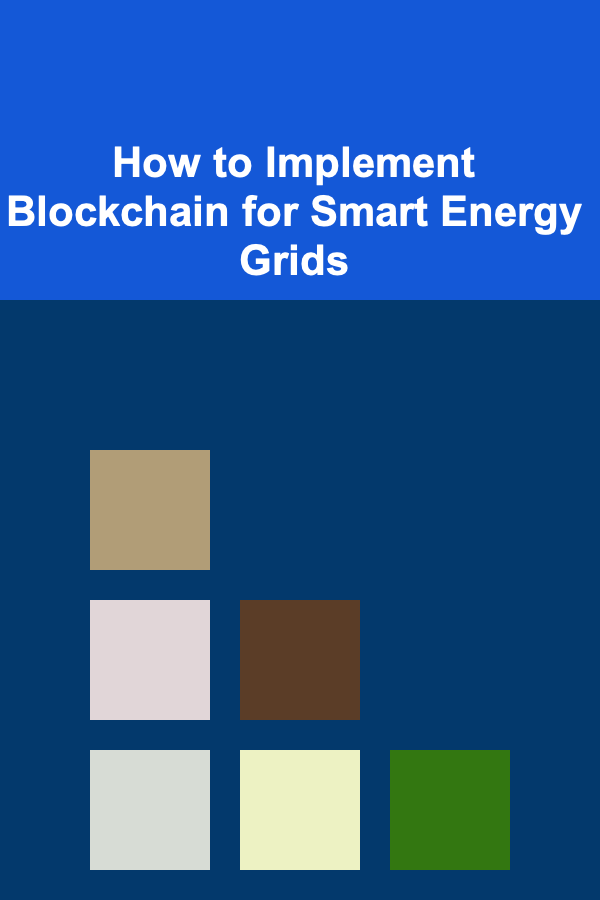
How to Implement Blockchain for Smart Energy Grids
ebook include PDF & Audio bundle (Micro Guide)
$12.99$5.99
Limited Time Offer! Order within the next:

The integration of blockchain technology into the energy sector has been gaining significant attention in recent years. Specifically, when applied to smart energy grids, blockchain has the potential to revolutionize how energy is distributed, tracked, and traded. A smart energy grid is an advanced system that uses digital communication technology to monitor and manage the flow of electricity from all generation sources to meet the varying energy demands of end users. Blockchain, on the other hand, is a decentralized and distributed ledger technology that ensures transparency, security, and immutability of transactions.
In this article, we will explore how blockchain can be implemented for smart energy grids, focusing on the benefits, challenges, and practical applications. We will also look into the various use cases and the steps involved in the integration process.
Understanding Blockchain Technology
Blockchain is a decentralized digital ledger that records transactions across multiple computers in a way that ensures the data is secure, transparent, and immutable. Each transaction, or "block," is linked to a previous one, forming a "chain" of blocks. This structure makes blockchain highly resistant to tampering, fraud, and hacking. The main characteristics of blockchain technology are:
- Decentralization: Blockchain operates without a central authority, meaning that no single party has control over the entire system. Instead, the control is distributed across all participants in the network.
- Transparency: Every transaction is visible to all participants in the network. This transparency builds trust and accountability.
- Immutability: Once a transaction is recorded on the blockchain, it cannot be altered or deleted, ensuring data integrity.
- Security: Blockchain employs cryptographic algorithms to secure transactions, making it difficult for malicious actors to manipulate the data.
The Role of Smart Energy Grids
Smart energy grids are the backbone of modern energy distribution systems. They enable the integration of renewable energy sources, real-time monitoring, and bidirectional communication between consumers and suppliers. These grids use sensors, meters, and data analytics to improve the efficiency, reliability, and sustainability of energy distribution.
Some key features of smart energy grids include:
- Demand-Response Management: Smart grids can respond to changes in energy demand, adjusting supply accordingly to ensure efficiency and prevent outages.
- Renewable Energy Integration: They enable the seamless integration of renewable energy sources like solar, wind, and hydro into the grid, optimizing their use.
- Two-way Communication: Smart grids allow consumers and suppliers to communicate in real-time, enabling features like dynamic pricing and better energy consumption management.
- Data Analytics: Advanced analytics tools are used to predict energy usage patterns and optimize energy distribution based on real-time data.
However, despite these advancements, smart grids face several challenges, including data security, transparency, and trust. These challenges can be mitigated by incorporating blockchain technology into the grid infrastructure.
Why Blockchain is Suitable for Smart Energy Grids
Blockchain offers several advantages when integrated into smart energy grids. These advantages address the major challenges faced by traditional energy systems:
3.1. Enhancing Transparency
One of the key benefits of blockchain in smart energy grids is enhanced transparency. Blockchain allows all participants in the energy market---such as energy producers, consumers, and intermediaries---to view and verify transactions in real-time. This ensures that all parties are aware of the energy flow, pricing, and usage. Transparency builds trust and reduces the risk of fraud or manipulation.
For instance, when energy is traded on a blockchain-enabled platform, the transaction details are publicly recorded, which can help to avoid disputes over billing or energy supply. Consumers can track the source of the energy they consume, which promotes sustainability and supports the use of renewable energy.
3.2. Ensuring Security
Smart grids handle sensitive data, including energy consumption patterns, user preferences, and financial transactions. Ensuring the security of this data is paramount. Blockchain provides a high level of security by utilizing cryptographic techniques that protect transaction data from unauthorized access or tampering.
Each transaction recorded on the blockchain is encrypted, and consensus algorithms ensure that all participants agree on the state of the network. This decentralized nature of blockchain makes it more resistant to cyber-attacks and fraud than traditional centralized systems.
3.3. Facilitating Peer-to-Peer (P2P) Energy Trading
Blockchain enables the creation of decentralized platforms for peer-to-peer (P2P) energy trading. In a P2P energy market, consumers who generate their own energy (e.g., through solar panels) can sell excess energy directly to other consumers without the need for intermediaries like utilities. Blockchain ensures that these transactions are secure, transparent, and trustworthy.
By using smart contracts, energy transactions can be automatically executed when predefined conditions are met. This eliminates the need for third-party brokers and reduces transaction costs, making energy trading more efficient and affordable.
3.4. Enabling Smart Contracts for Energy Management
Smart contracts are self-executing contracts with the terms of the agreement directly written into code. In the context of smart energy grids, smart contracts can automate energy transactions, billing, and grid management. For example, when a consumer generates excess solar energy, a smart contract can automatically initiate a payment to the consumer based on the amount of energy sold.
Smart contracts can also be used for demand-response management, where the grid adjusts its supply based on energy consumption patterns. For example, when energy demand is high, the smart contract can trigger actions to reduce consumption or increase supply from renewable sources.
3.5. Reducing Operational Costs
Blockchain can streamline operations in the energy sector by eliminating intermediaries and reducing administrative costs. For example, blockchain can automate billing and payment processes, reducing the need for manual intervention. This reduces the costs associated with handling payments, disputes, and audits.
Additionally, blockchain can improve grid management by enabling real-time monitoring and reporting. This reduces the need for manual data collection and analysis, further cutting operational costs.
Practical Applications of Blockchain in Smart Energy Grids
Blockchain can be applied to various aspects of smart energy grids, including energy trading, grid management, and data sharing. Here are some key use cases:
4.1. Energy Trading Platforms
Blockchain can facilitate the creation of decentralized energy trading platforms, where energy producers and consumers can directly trade energy. These platforms can use smart contracts to ensure that energy transactions are executed automatically when certain conditions are met. Blockchain ensures transparency, security, and efficiency in these transactions.
For instance, companies like Power Ledger and Brooklyn Microgrid have already developed blockchain-based platforms that enable local energy trading. Consumers can sell excess energy generated from solar panels to other users in their community, reducing reliance on centralized utilities.
4.2. Decentralized Grid Management
Blockchain can be used to manage decentralized energy grids, where multiple producers contribute energy to the grid. By using blockchain, energy flow can be tracked in real-time, ensuring that the correct amount of energy is delivered to consumers. This can also help in optimizing the use of renewable energy sources and preventing energy waste.
For example, blockchain can record the energy generated from renewable sources like solar or wind, allowing consumers to track the source of their energy and ensuring that it comes from sustainable sources. This promotes trust and accountability in the grid system.
4.3. Renewable Energy Certificates (RECs)
Renewable Energy Certificates (RECs) are used to verify that a certain amount of energy has been produced from renewable sources. Blockchain can provide a transparent and secure way to track the issuance and transfer of RECs. By recording every transaction on the blockchain, it becomes easy to verify the authenticity of RECs and prevent fraud.
This can be especially useful for businesses and individuals who wish to demonstrate their commitment to sustainability by purchasing renewable energy certificates.
4.4. Energy Consumption Data Sharing
Blockchain can enable secure and transparent sharing of energy consumption data. This can be particularly useful for utilities, regulators, and consumers. For example, consumers can securely share their energy usage data with utilities, who can then use this data to offer personalized energy-saving recommendations or dynamic pricing options.
Blockchain ensures that this data is not tampered with and that consumers' privacy is maintained. This also helps utilities and energy companies comply with regulations around data security and privacy.
4.5. Grid Security and Resilience
Blockchain can enhance the security and resilience of the grid by providing a decentralized way to manage and monitor energy flow. In the event of a cyber-attack or other disruptive event, blockchain can ensure that the grid remains secure and that the integrity of energy transactions is maintained.
Additionally, blockchain can be used to implement secure access control systems for grid operators and maintenance personnel, reducing the risk of unauthorized access to critical grid infrastructure.
Challenges in Implementing Blockchain for Smart Energy Grids
While the potential benefits of blockchain in smart energy grids are immense, there are several challenges that must be overcome to successfully implement this technology:
5.1. Scalability
Blockchain networks, particularly public blockchains, can face scalability issues due to the need for all participants to verify and record every transaction. As the number of transactions increases, the network can become congested, leading to delays and higher transaction costs.
To address this challenge, various blockchain solutions like Ethereum 2.0 and layer 2 solutions (e.g., the Lightning Network) are being developed to improve scalability. However, scalability remains a key concern in large-scale implementations.
5.2. Regulatory and Legal Issues
The energy sector is heavily regulated, and the integration of blockchain into smart energy grids must comply with existing regulations. Issues like energy trading, data privacy, and the use of smart contracts need to be addressed within the legal framework.
Governments and regulatory bodies must develop clear guidelines and standards for the use of blockchain in energy systems. This includes ensuring that blockchain-based energy trading platforms comply with energy market rules and consumer protection laws.
5.3. Interoperability
For blockchain to be effective in smart energy grids, it must be able to interact with existing energy infrastructure and technologies. Ensuring interoperability between blockchain systems and legacy systems is a significant challenge. Standards need to be developed to ensure that different blockchain platforms can communicate and share data effectively.
5.4. Energy Consumption of Blockchain Networks
While blockchain offers numerous benefits, it is important to consider the energy consumption of the blockchain networks themselves. Proof-of-work (PoW) consensus algorithms, used in cryptocurrencies like Bitcoin, require significant computational power and energy consumption.
However, newer consensus mechanisms like proof-of-stake (PoS) are more energy-efficient and may be better suited for integration with smart energy grids.
Conclusion
Blockchain technology holds great potential for transforming smart energy grids by enhancing transparency, security, and efficiency. By enabling decentralized energy trading, automating grid management through smart contracts, and improving data sharing and monitoring, blockchain can help create more resilient and sustainable energy systems.
However, implementing blockchain for smart energy grids is not without challenges. Issues like scalability, regulatory compliance, interoperability, and energy consumption must be addressed to realize the full potential of this technology. Nevertheless, with continued innovation and collaboration between the energy sector, technology providers, and regulators, blockchain has the potential to play a pivotal role in shaping the future of smart energy grids.

Beginner's Guide to Online Marketing
Read More
How to Inspire Others with Your Organized Wellness Journey
Read More
How to Organize Cables and Chargers to Reduce Clutter
Read More
How to Refresh Your Home Office with Seasonal Decor
Read More
How to Write Clear and Concise Technical Specifications
Read More
How to Use Table Numbers to Guide Guests Effectively
Read MoreOther Products

Beginner's Guide to Online Marketing
Read More
How to Inspire Others with Your Organized Wellness Journey
Read More
How to Organize Cables and Chargers to Reduce Clutter
Read More
How to Refresh Your Home Office with Seasonal Decor
Read More
How to Write Clear and Concise Technical Specifications
Read More